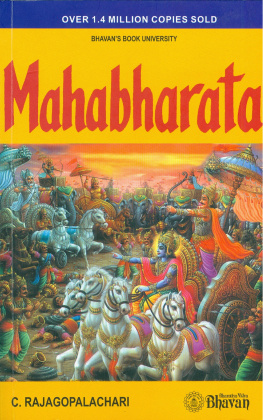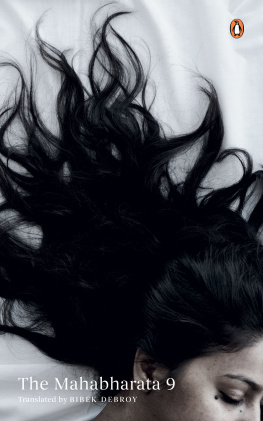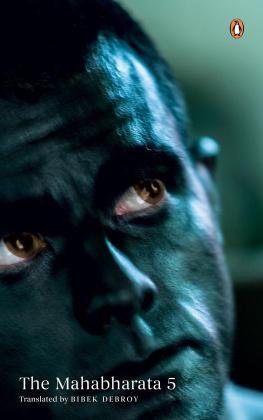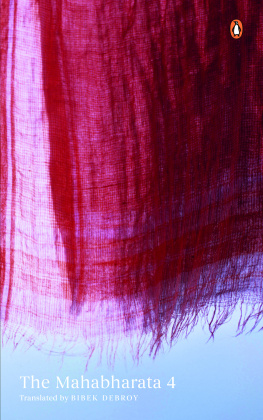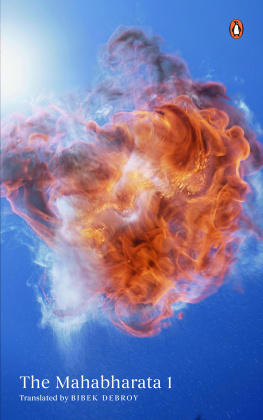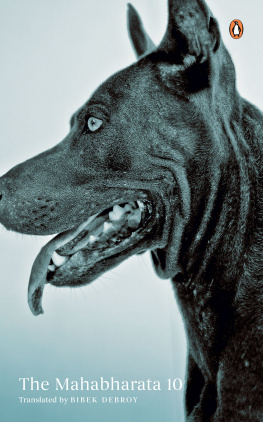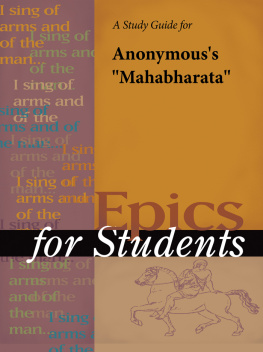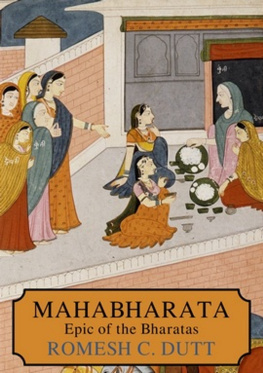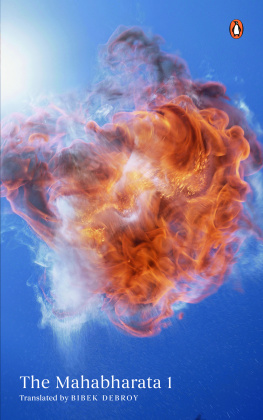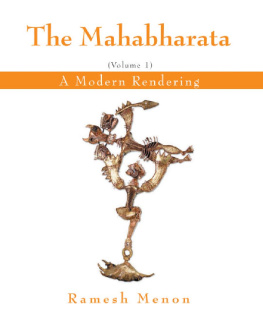MAHABHARATA
By
C. Rajagopalachari
Let noble thoughts come to us from every side.
-Rigveda. 1-89-i
BHAVANS BOOK UNIVERSITY
MAHABHARATA
By
C. RAJAGOPALACHARI
Approved by Kurukshetra University vide circular No. Eng/2005.675 Dated 29.5.2005 for B. A. IInd year.
2015
BHARATIYA VIDYA BHAVAN
Kulapati K. M Munshi Marg, Mumbai 400 007
All Rights Reserved
Bharatiya Vidya Bhavan
Kulapati Munshi Marg
Mumbai - 400 007
BOOKS BY C. RAJAPOPALACHARI
PUBLISHED BY BHAVAN
- Mahabharata
- Ramayana
- Rajajis Speeches Vol. 1
- Rajajis Speeches Vol. 2
- Hinduism : doctrine and Way of Life
- Bhagavad gita
- Stories for the Innocent
- Kural the great Book of Tiru-Valluvar
- Upanishads
- Our Culture
- Gandhijis Teachings & Philosophy
- Avvaiar ( The Great Tamil Poet)
- Kathopanishad (Tamil)
- Rescue Democracy From Money Power
- Bhagavad Gita ( Hindi)
- Upanishads (Hindi-cum- English Edition)
- Bhajagovind (Kannada)
PUBLISHED BY
Bharatiya Vidya Bhavan,
K.M. Munshi Marg, Mumbai - 400007.
E-mail:
Website: http://www.bhavans.info
CONTENTS
KULAPATIS PREFACE
THE Bharatiya Vidya Bhavan - that Institute of Indian Culture in Bombay - needed a Book University, a series of books which, it read, would serve the purpose of providing higher education. Particular emphasis, however, was to be put on such literature as revealed the deeper impulsions of India. As a first step, it was decided to bring out in English 100 books, 50 of which were to be taken in hand almost at once. Each book was to contain from 200 to 250 pages.
It is our intention to publish the books we select, not only in English, but also in the following Indian languages: Hindi, Bengali, Gujarati, Marathi, Tamil, Telugu, Kannada and Malayalam.
This scheme, involving the publication of 900 volumes, requires ample funds and an all-India organisation. The Bhavan is exerting its utmost to supply them.
The objectives for which the Bhavan stands are the re-integration of Indian culture in the light of modern knowledge and to suit our present-day needs and the resuscitation of its fundamental values in their pristine vigour.
Let me make our goal more explicit:-
We seek the dignity of man, which necessarily implies the creation of social conditions which would allow him freedom to evolve along the lines of his own temperament and capacities; we seek the harmony of individual efforts and social relations, not in any makeshift way, but within the frame-work of the Moral Order; we seek the creative art of life, by the alchemy of which human limitations are progressively trans- muted, so that man may become the instrument of God, and is able to see Him in all and all in Him.
The world, we feel, is too much with us. Nothing would uplift or inspire us so much as the beauty and aspiration which such books can teach. In this series, therefore, the literature of India, ancient and modern, will be published in a form easily accessible to all Books in other literatures of the world. If they illustrate the principles we stand for, will also be included.
This common pool of literature, it is hoped, will enable the reader, eastern or western, to understand and appreciate currents of world thought, as also the movements of the mind in India, which, though they flow through different linguistic channels, have a common urge and aspiration.
Fittingly, the Book University's first venture is the Mahabharata , summarised by one of the greatest living Indians: C. Rajagopalachari. The second work is on a section of it, the Gita by H.V. Divatia, an eminent jurist and a student of philosophy. Centuries ago, it was proclaimed of the Mahabharata: What is not in it, is nowhere. After twenty-five centuries, we can use the same words about it. He who knows it not, knows not the heights and depths of the soul: he misses the trials and tragedy and the beauty and grandeur of life.
The Mahabharata is not a mere epic; it is a romance, telling the tale of heroic men and women and of some who were divine: it is a whole literature in itself, containing a code of life; a philosophy of social and ethical relations, and speculative thought on human problems that is hard to rival; but above all, it has for its core the Gita, which is, as the world is beginning to find out, the noblest of scriptures and the grandest of sagas in which the climax is reached in the wondrous Apocalypse in the Eleventh Canto.
Through such books alone the harmonics underlying true culture, I am convinced, will one day reconcile the disorders of modern life.
I thank all those who have helped to make this new branch of the Bhavans activity successful.
PREFACE TO FIRST EDITION
IT is not an exaggeration to say that the persons and incidents portrayed in the great literature of a people influence national character no less potently than the actual heroes and events enshrined in its history. It may be claimed that the former play an even more important part in the formation of ideals, which give to character its impulse of growth. Don Quixote, Gulliver, Pickwick, Sam Weller, Sir Roger de Coverley, Falstaff, Shylock, King Arthur, Sir Lancelot, Alice and her wanderings in Wonderland, all these and many such other creations of genius are not less real in the minds of the British people than the men and women who lived and died and lie buried in British soil. Since literature is so vitally related to life and character, it follows that so long as the human family remains divided into nations, the personae and events of one national literature have not an equal appeal to all, because they do not awaken the same associations. A word or phrase about Falstalf or Uncle Toby carries to English men a world of significance which it does not to others. Similarly, a word or phrase about Hanuman, Bhima, Arjuna, Bharata or Sita conveys to us in India, learned and illiterate alike, a significance all its own, of which an English rendering cannot convey even a fraction to outsiders, however interested in Indian mythology and folklore.
In the moving history of our land, from time immemorial great minds have been formed and nourished and touched to heroic deeds by the Ramayana and the Mahabharata. In most Indian homes, children formerly learnt these immortal stories as they learnt their mother tongue - at the mother's knee; and the sweetness and sorrows of Sita and Draupadi, the heroic fortitude of Rama and Arjuna and the loving fidelity of Lakshmana and Hanuman became the stuff of their young philosophy of life.
The growing complexity of life has changed the simple pattern of early home life. Still, there are few in our land who do not know the Ramayana and the Mahabharata, though the stories come to them so embroidered with the garish fancies of the Kalakshepam* and the cinema as to retain but little of the dignity and approach to truth of Vyasa or Valmiki. It occurred to me some years ago that I might employ some of the scanty leisure of a busy life in giving to our Tamil children in easy prose the story of the Mahabharata that we, more fortunate in this than they, heard in our homes as children. Vyasas Mahabharata is one of our noblest heritages, and it is my cherished belief that to hear it faithfully told is to love it and come under its elevating influence. It strengthens the soul and drives home - as nothing else does - the vanity of ambition and the evil and futility of anger and hatred. Some years ago, I wrote the story of Sisupala under the caption Mudal Tambulam (precedence in Guest-Worship) for a Tamil magazine. The editor liked it so much that he persuaded me to take up the task of giving the whole of the Mahabharata to our people in the form of stories. The work, which I began with some diffidenc e , soon cast its spell on me, and presently I came to love it and imagined myself telling these stories to dear Tamil children, clustering eager-eyed to hear the deeds of the godlike heroes of our motherland. I also hoped that the reading of these stories might enliven village evenings, when rustics gather socially in the chavadi or temple after their day's work is done. I covered the Mahabharata in 107 stories. The writing recaptured for me sacred and touching associations which are part of my life; every sentence had for me a fragrance of the living past. This quality can never of course be preserved or brought out in an English translation. All the same, I hope this book will serve some purpose. I did a substantial part of the translation myself, but a great part was done for me by kind friends. I tender my most grateful thanks to Sri P. Seshadri and to Sri S. Krishnamurti, without whose labours this book would not have been possible. Last but not least, I am grateful to Sri Navaratna Rama Rao, whose help by way of careful revision of the entire manuscript is as much a precious memento of personal affection as public service.

